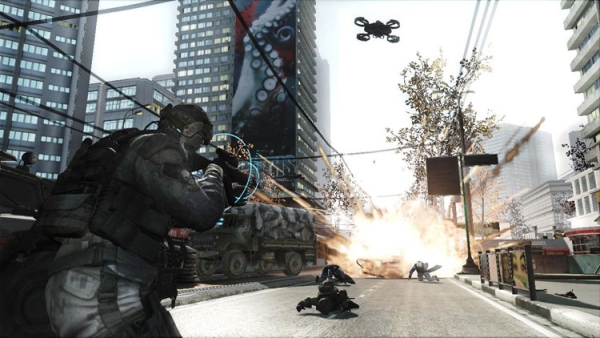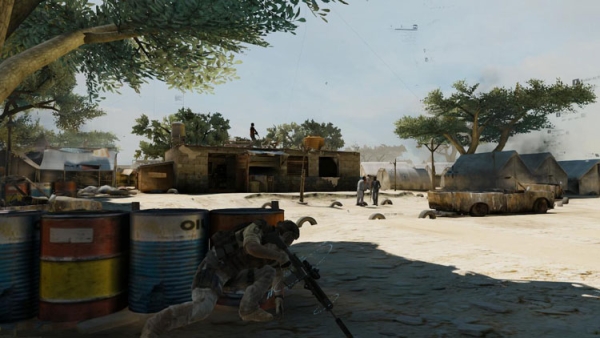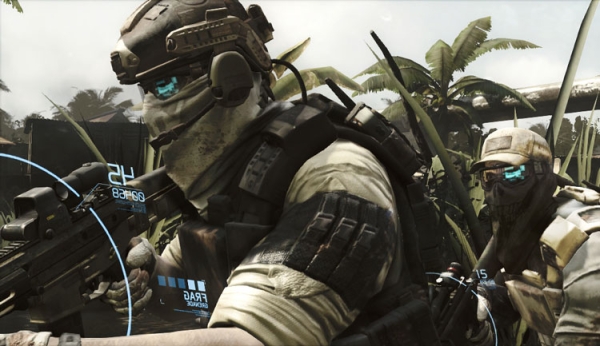Gameplay in Ghost Recon: Future Soldier is merciless and realistic without becoming a third person ARMA III or Operation Flashpoint. Each team is composed of two four-man fire teams. Staying in cover is vital to your survival and making stupid or brash decisions will be punished. Intel is worth more than its weight in gold, allowing players to get the drop on their enemies and exploit weakness. It is possible to mortally wound or stun an enemy and then hack his data feed to gain vital intelligence on every enemy player’s positions for a short period of time. I really enjoyed the fact this rewarded players who stay together and protect each other. Running around alone is not only stupid in Future Soldier; it invites a humiliating take down by stun gun followed by a punishing few minutes of vulnerability for the entire team. Games are not won by those who kill the most, but those who kill the most to defend or capture objectives. Unfortunately, due to the nature of most players these days, games often devolve into team death match mentality with little regard of objectives.
The controls in for the most part are solid. Gears of War players will be instantly familiar with Ghost Recon: Future Soldier’s control scheme. Those coming from Call of Duty or similar first person games may have a slightly more difficult time transitioning. Ghost Recon: Future Soldier is a hybrid third person shooter with some heavy first person shooter elements. There are three perspectives the game is played from and the transition between them is extremely smooth. The only way to fire accurately is to aim down the sights. Considering aiming down sights is so important in Ghost Recon: Future Soldier, I am surprised that alternate control schemes were not offered in the Beta. Currently, the left trigger will tighten the camera to a directly over the shoulder perspective, allowing players to shoot with slight accuracy. To bring up the sights, players need to press the right thumb stick to fire accurately. To put things in perspective, shooting without going into any aiming mode will mean players won’t hit the broad side of a barn, zooming into the left trigger will provide the odd shot will hit their target, while looking down the sights and firing is the only real way to put accurate fire into the target. Although the control scheme works, I would prefer to see a control scheme available that puts the look down the sights action to the left trigger, while the zoom over the shoulder will be triggered by pressing the right thumb stick. This set up will probably be more familiar with FPS players and I believe would be a generally more useful control scheme. Zoomed over the shoulder allows players to fire while moving, but I found Future Soldier to emphasize realism so much that firing on the move was only useful to suppress the enemy or engaging enemies who were within 10 meters or less. In the final game, I would like to see some alternative control schemes, but the controls in general were well done.

The deep gun customization is the shining star of Ghost Recon: Future Soldier that sets it apart from the competitors. Unlike the ridiculously inaccurate lego system that Army of Two favours and the simple scopes, suppressors, launchers, and paint of the Call of Duty and Battlefield series, Future Soldier provides deep customization of guns that attempts to balance realism with user friendly design. Stocks can be swapped out to tweak the mobility and the stability of guns. An assortment of scopes, under barrel launchers, suppressors, vertical foregrips, and bipods can be attached. Practically everything and a coffee maker can be stuck to a weapon. Magazine modifications can allow for different types of ammunition or larger magazine capacity. Even rarer customization options are available with Ghost Recon: Future Soldier. Triggers can be changed to provide a more sensitive trigger or lock the gun to semi auto or burst fire modes. Gas systems can be tweaked to adjust the fire rate and control of a weapon. Each modification is unlocked by attachment credits earned by levelling up. Once players are done customizing, they can slap on a coat of paint to camouflage the weapon to taste.
This game is a gun nut’s fantasy come true. It’s obvious great care has been taken for the gun customization screen. Opening a gun to customize will cause it to disassemble and spread the parts out like a manual’s parts breakdown diagram. Players can manipulate the view or reassemble the gun with a button press or push of a thumb stick. By pressing left or right, players can navigate the menus to change modifications for the weapon. For those players who don’t want to become lost within the gun customization menus, four quick presets are available that will choose the best possible set ups with the parts owned, focusing on control, maneuverability, power, or range. For the brave, a random mode is available, which will throw random attachments onto your weapon. Although Kinect integration was not available for beta, it is very obvious that the UI was designed with Kinect in mind. Probably the best feature of the gun customization is the firing range. From within the gun customization screen, it is possible to jump into a firing range to test fire your current weapon builds almost instantly. There is only a split second load time to go from customization to the firing range.

There are only two flaws with the gun customization system. One, I found the camouflage patterns to be much brighter than their real life counterparts. For example Canadian CADPAT looked like a bright lime green camouflage rather than the dark greens used in real life. Some patterns were so bright that it was hard to recognize them as the pattern. Slightly more troubling was the amount of menus needed to tackle the customization. Although the in-game gun customization menus are simpler, some players will become overwhelmed by the amount of menus needed to shuffle through to customize their weapons. Although the quick presets provide an easy method to customize weapons, players still need to wade through the menus once in a while to purchase attachments. Gun nuts and detail oriented players will thrive with the gun customization options in Ghost Recon: Future Soldier. It is possible to get lost for hours playing with different gun builds and it’s obvious that it was designed that way. Unfortunately some players just want their gun and get into the fight as quickly as possible.
The hit detection due to lag could be terrible in Ghost Recon: Future Soldier at time. There were many moments that the game lagged intensely. I have chalked it up to a combination of beta status and the lack of dedicated servers. Unfortunately dedicated servers are a rarity on consoles, which is an utter shame considering shooters are so popular on the platform. Hopefully, the latency issues will be ironed out with the final release of the game. Beyond a few graphical glitches and lag issues, Ghost Recon: Future Soldier looks like it is nearing a solid release.
Ghost Recon: Future Soldier is shaping up to be a solid contender in a busy release schedule for game of the year. Although the competition is stiff this year, Ghost Recon: Future Soldier brings well designed maps, balanced classes, incredibly fun team based gameplay, and addictively deep weapon customization options in the closed beta. If this is a sign for what is to come, Ubisoft is on track to release a stellar game.


